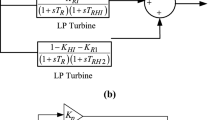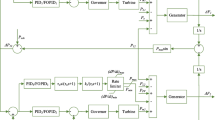Abstract
Currently, more than 60 units of generating equipment for power plants are involved in standardized primary frequency control (SPFC). The active power of such power units or turbines should vary in proportion to the deviations of the network frequency (turbine rotation speed) with certain dynamic characteristics. For the objectivity of assessing the quality of power plants' participation in the SPFC, nine criteria were formulated, for which mathematical algorithms were developed. One of the important criteria that is used for automatic control of the participation of power plants in the SPFC is the assessment of the actual values of the “deadband” and statism of the primary regulation. In practice, when using the existing algorithm to determine the values of the deadband and statism of the primary regulation, an incorrect result is often obtained. Incorrect calculation results lead to economic losses of power plants participating in the SPFC and inadequate assessment of the technical state of turbine control systems. The article discusses the existing methodology for assessing the actual values of statism and deadband of the primary regulation of generating equipment when operating in normalized primary frequency regulation. The assumptions used in its development and leading to an additional error of the method are analyzed, for example, that the actual static characteristic is symmetrical relative to zero. Examples of incorrect calculations obtained using the existing methodology are given. An alternative method for evaluating these parameters of primary regulation, which allows them to be more accurately and objectively evaluated, is proposed and it is compared with the existing methodology. A description of the calculation algorithm using an alternative method is given, its features and advantages are considered, including the absence of restrictions on the amount of initial data. Comparative graphs and data of estimates of the actual values of the deadband and statism of primary regulation, obtained using the considered algorithms, for various equipment involved in the normalized primary regulation of frequency are presented. It is shown that the values obtained using the proposed algorithm more adequately characterize the actual dependence of the generating equipment’s active power on changes in the network frequency, which makes it possible to obtain more representative and adequate data in comparison with the results of calculations using the existing methodology and, accordingly, to give an objective assessment of the generating equipment’s operation.





Similar content being viewed by others
Notes
All other generating equipment in Russia operates in general primary frequency control and must respond to network frequency deviations exceeding ±75 MHz (for combined cycle plants ±50 MHz).
REFERENCES
GOST R55890-2013. United Power System and Isolated Power Systems. Operative-Dispatch Management. Frequency Control and Control of Active Power. Norms and Requirements (Standartinform, Moscow, 2014).
The Procedure for Determining the Volume of Services Rendered by Rated Primary Frequency Regulation, Supplement No. 2 (Sist. Oper. EES, Moscow, 2020) [in Russian].
A. E. Efimov and V. Yu. Krylov, “Participation control criteria algorithms of power generating units of thermal power plants in standardized primary frequency control. Part 1,” Elektr. Stn., No. 11, 30–35 (2014).
A. E. Efimov and V. Yu. Krylov, “Participation control criteria algorithms of power generating units of thermal power plants in standardized primary frequency control. Part 2,” Elektr. Stn., No. 12, 12–17 (2014).
N. V. Zorchenko, A. G. Chaplin, O. V. Rad’kova, and T. G. Tyupina, “Primary frequency control and frequency control market development trends,” Elektr. Stn., No. 5, 31–34 (2020).
Author information
Authors and Affiliations
Corresponding author
Rights and permissions
About this article
Cite this article
Nikiforov, A.A., Chaplin, A.G. & Zorchenko, N.V. Methodology for Determining the Actual Values of Droop and Deadband for Primary Control of TPP Equipment. Therm. Eng. 68, 647–653 (2021). https://doi.org/10.1134/S0040601521050086
Received:
Revised:
Accepted:
Published:
Issue Date:
DOI: https://doi.org/10.1134/S0040601521050086




